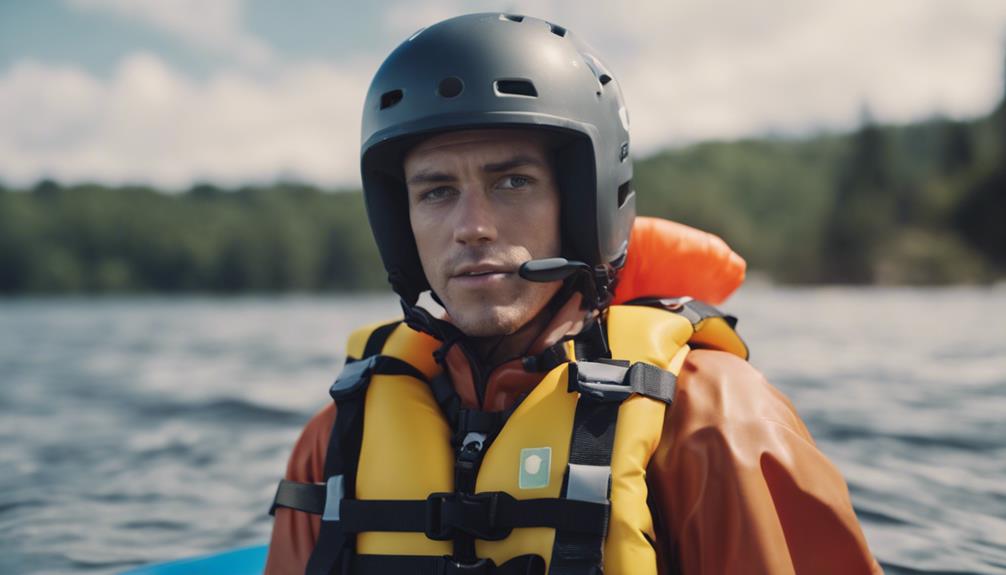Stay safe during water sports with essential safety tips. Wear a Coast Guard-approved life jacket for buoyancy. Follow boating guidelines, check weather, and be aware of surroundings to prevent accidents. Equip with proper gear and undergo skills training for well-being. Communicate effectively, support teamwork, and respect the environment to guarantee safety for all. Comply with regulations, understand liability waivers, and maintain equipment for a positive sport reputation. Essential tips include clear communication, hand signals, and life jacket usage to maximize fun and safety. Further insights await to enhance your water sports knowledge.
Key Takeaways
- Wear a Coast Guard-approved life jacket for buoyancy and safety.
- Establish clear communication practices for effective coordination on the water.
- Learn basic hand signals to enhance safety and avoid accidents.
- Follow boating safety guidelines to prevent collisions and ensure a safe experience.
- Check weather conditions before engaging in water sports to stay safe.
Importance of Water Sports Safety
Ensuring water sports safety is an essential aspect of enjoying aquatic activities without unnecessary risks or incidents. When engaging in water sports, following key safety tips is important to protect yourself, others, and the environment. By prioritizing water safety, you not only enhance your personal well-being but also contribute to a positive experience for everyone involved.
Proper safety measures play a critical role in preventing accidents, injuries, and even fatalities that can occur during recreational activities on the water. Adhering to water safety guidelines not only safeguards participants and bystanders but also helps in avoiding legal compliance issues and potential fines for non-compliance.
Educating yourself and others about water sports safety is key to promoting awareness and reducing the likelihood of emergencies or mishaps. Remember, taking the time to familiarize yourself with safety protocols and practicing caution while enjoying water sports can make all the difference in ensuring a safe and enjoyable experience for everyone.
Preventing Accidents and Injuries

To prevent accidents and injuries during water sports, implementing proper safety measures is essential. Safety should always be a top priority when engaging in any water activity.
Wearing a personal flotation device (PFD) is vital, as it can greatly reduce the risk of drowning in case of an accident. Additionally, following boating safety guidelines, such as maintaining a safe speed, avoiding alcohol consumption, and being aware of your surroundings, can help prevent collisions and falls.
Checking the weather before heading out is also key to ensuring a safe experience. Sudden storms or rough waters can pose serious dangers, so always be prepared and informed about the conditions.
Ensuring Personal Well-Being

To guarantee your personal well-being during water sports, it's crucial to prioritize safety by wearing the appropriate gear and undergoing skills training. These measures are essential in safeguarding your health and minimizing the risk of accidents or injuries while engaging in water activities.
Gear for Safety
Make sure you equip yourself with essential safety gear to protect your well-being during water sports activities.
Wearing a life jacket is vital as it can greatly reduce the risk of drowning by 80%. Additionally, investing in properly maintained safety equipment such as helmets and padded vests can prevent serious injuries in case of accidents.
High-visibility gear, like brightly colored rash guards or vests, enhances your visibility in the water, reducing the chances of collisions with other water enthusiasts. Quality gear, such as impact-resistant goggles for water skiing or wakeboarding, can safeguard your eyes from potential injuries.
Remember that the correct fit of safety equipment is key to maximizing their effectiveness during emergencies. Make sure that helmets fit snugly and life jackets are securely fastened to provide excellent protection.
Skills Training Vital
Developing essential skills through proper training is important for ensuring your personal well-being during water sports activities. Skills training plays a key role in water sports safety by reducing the risk of accidents and injuries. By participating in training programs, individuals can learn how to navigate water conditions effectively and understand the importance of using safety equipment.
These programs focus on teaching essential skills like swimming, proper use of gear, and emergency protocols, all of which are essential for overall safety while engaging in water sports.
Acquiring the necessary skills through training not only enhances your personal safety but also contributes to a more enjoyable and fulfilling water sports experience. By being well-prepared and knowledgeable about how to handle various situations that may arise in the water, you can greatly decrease the likelihood of accidents and injuries.
Investing time in skills training is a proactive step towards minimizing risks and maximizing your well-being during water sports activities.
Protecting Others on the Water
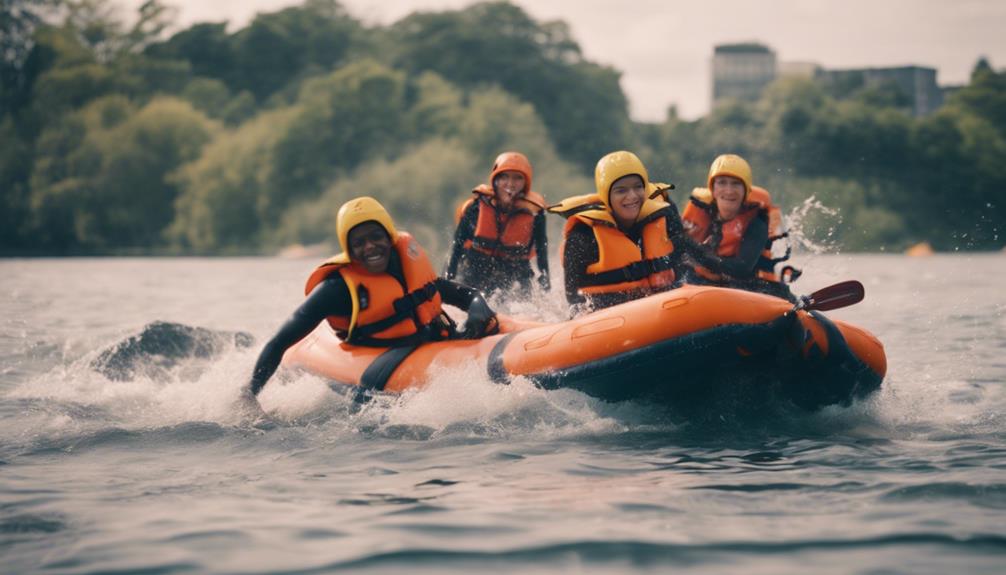
Protecting others on the water is an essential responsibility for all participants in water sports. When engaging in water activities, guaranteeing the safety of both fellow participants and bystanders is vital to prevent accidents and promote an environment of trust and support.
Here are five key ways to protect others on the water:
- Always wear a Coast Guard-approved life jacket or personal flotation device (PFD) to secure buoyancy and safety in case of emergencies.
- Follow safety guidelines and regulations specific to the water sport you're participating in to minimize risks and prevent accidents.
- Communicate effectively with other individuals on the water to coordinate movements and avoid collisions or dangerous situations.
- Be aware of your surroundings at all times and keep an eye out for fellow participants who may need assistance or guidance.
- Support a culture of teamwork and mutual respect to create a safe and inclusive water environment for everyone involved.
Mitigating Environmental Impact

Mitigating environmental impact in water sports involves practicing responsible waste disposal and respecting marine ecosystems to preserve the delicate balance of aquatic environments. Proper waste disposal not only helps minimize pollution but also reduces harm to marine ecosystems.
Respecting marine life and habitats is essential as it guarantees the sustainability of aquatic environments. Adhering to waterways guidelines is another important aspect as it helps in minimizing the negative impact of water sports on the environment.
By understanding and following regulations, water sports enthusiasts can actively contribute to protecting the natural beauty of water bodies for future generations. Being mindful of environmental impact is critical as it plays a significant role in maintaining the overall health and balance of marine ecosystems.
Legal Compliance for Water Sports
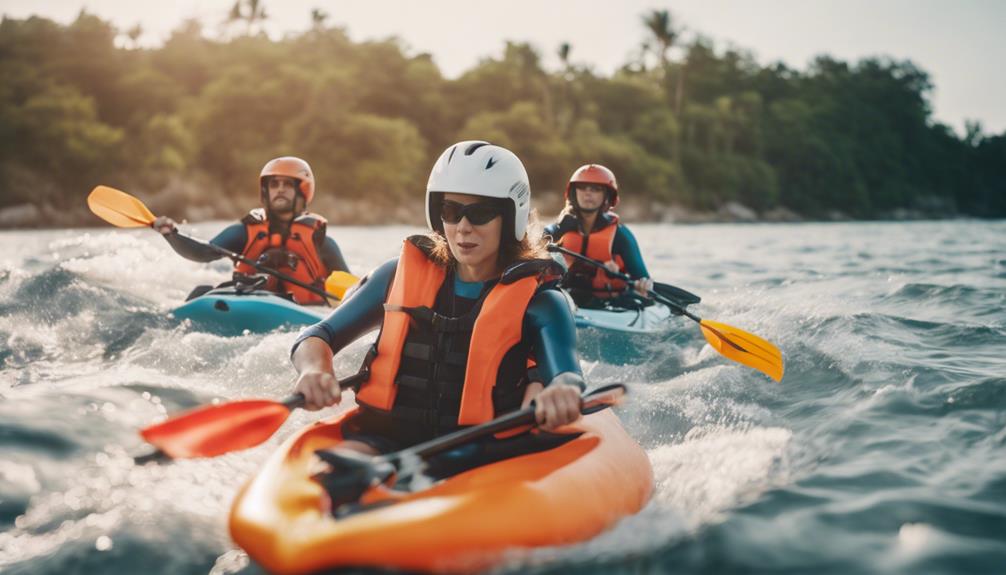
Ensuring legal compliance in water sports is vital to your safety and the well-being of others.
Understanding safety gear requirements, regulations, permits, and liability waivers is essential to avoid potential fines and legal consequences.
Safety Gear Requirements
In order to comply with legal regulations for water sports, make sure you have the necessary safety gear such as personal flotation devices, helmets, wetsuits, or impact vests.
When participating in water sports activities, safety gear requirements are in place to guarantee your well-being and legal compliance. Here are some essential safety gear items you should always have on hand:
- Personal Flotation Device (PFD): A must for all water sports to keep you afloat in case of emergencies.
- Helmet: Protects your head from potential impacts during activities like kayaking or wakeboarding.
- Wetsuit: Helps regulate body temperature and provides an extra layer of protection against cold water.
- Impact Vest: Adds buoyancy and shields your torso from injuries, especially in high-impact sports.
- Water Shoes: Prevents slipping and protects your feet from sharp objects in the water.
Regulations and Permits
To engage in water sports safely and lawfully, it's imperative to familiarize yourself with the specific regulations and permit requirements applicable to your chosen activity and location. Regulations and permits for water sports play an essential role in guaranteeing both safety and legal compliance.
Different jurisdictions have varying laws and guidelines in place to regulate water sports activities, aiming to prevent accidents and protect participants and the environment. By following these regulations and obtaining the necessary permits, you not only reduce the risk of fines and penalties but also contribute to a safer overall experience on the water.
Compliance with the specific regulations and permit requirements for your chosen water sport is essential. These guidelines are designed to uphold safety standards, promote responsible behavior, and minimize potential risks associated with water sports. Understanding and adhering to these legal requirements not only ensure a smooth and enjoyable experience but also help maintain the integrity of the water sports community.
Liability Waivers Explained
Understanding liability waivers is key when it comes to legal compliance for water sports, particularly in specifying the responsibilities of operators and participants. Liability waivers are legal documents participants sign to release operators from responsibility for injuries during water sports activities. However, they aren't foolproof and may not protect operators from all liability claims, especially in cases of negligence or intentional harm. To be legally binding, waivers must be clearly written, specific, and signed voluntarily by participants. Courts may still review waivers for validity and fairness in cases of disputes or legal claims. It's crucial for both operators and participants to grasp the implications of liability waivers to navigate the legal responsibilities involved in water sports activities effectively.
- Ensure waivers are clearly written and specific.
- Participants must sign waivers voluntarily.
- Waivers may not protect against all liability claims.
- Courts can review waivers for validity and fairness.
- Understanding liability waivers is crucial for legal compliance in water sports.
Promoting Enjoyment and Longevity
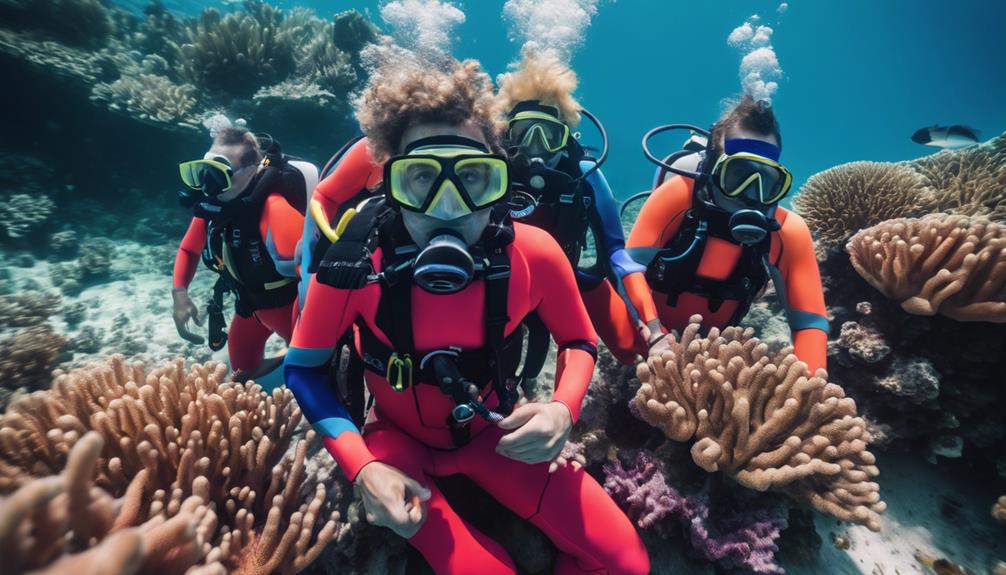
Ensuring your safety while engaging in water sports not only enhances your enjoyment but also contributes to a long-lasting and fulfilling experience. By following essential safety tips, you create a safe environment that allows you to fully immerse yourself in the thrill of water activities without unnecessary risks.
Implementing safety guidelines is essential for minimizing accidents and injuries, ensuring that your time spent participating in water sports isn't only fun but also sustainable in the long run.
Prioritizing safety measures is key to enhancing your overall well-being as a water sports enthusiast. By adhering to safety protocols, you greatly reduce the chances of harm, thereby maximizing the enjoyment derived from these activities.
Building a Positive Sport Reputation
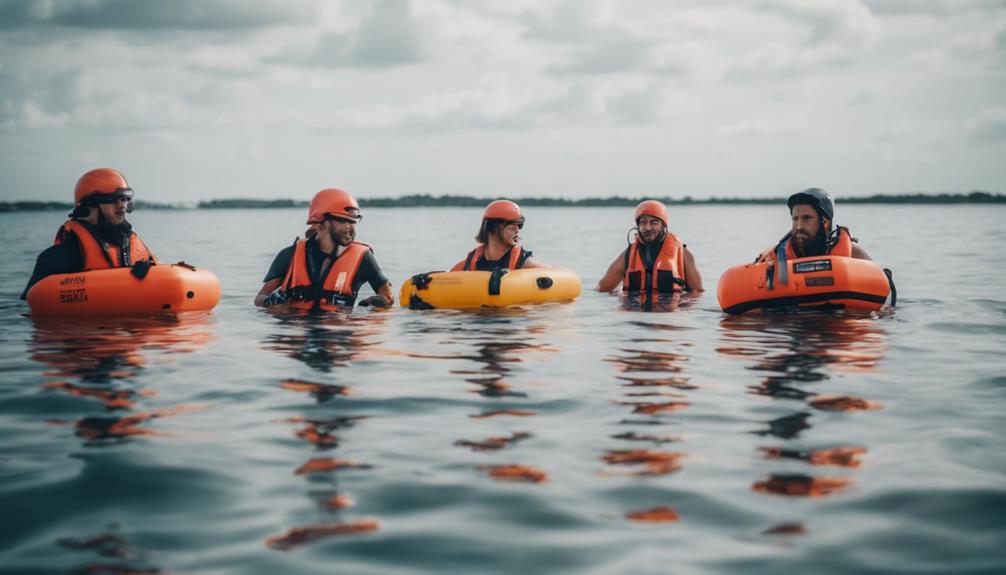
Prioritize promoting a positive reputation for water sports by emphasizing safety protocols and responsible behavior. To guarantee a strong and trustworthy image within the water sports community, consider the following key strategies:
- Check Equipment Regularly: Before engaging in any water sport activity, thoroughly inspect your gear to confirm it's in good working condition.
- Enroll in Swimming Lessons: Enhance your water safety skills by enrolling in swimming lessons to build confidence and competence in the water.
- Maintain a Safe Environment: Always be mindful of your surroundings and take necessary precautions to prevent accidents and injuries.
- Slip and Fall Awareness: Be cautious of slippery surfaces near water bodies to avoid falls that could lead to potential harm.
- Respect Rules and Regulations: Adhere to all safety guidelines and regulations set forth for water sports to promote a culture of responsibility and well-being.
Essential Water Safety Tips
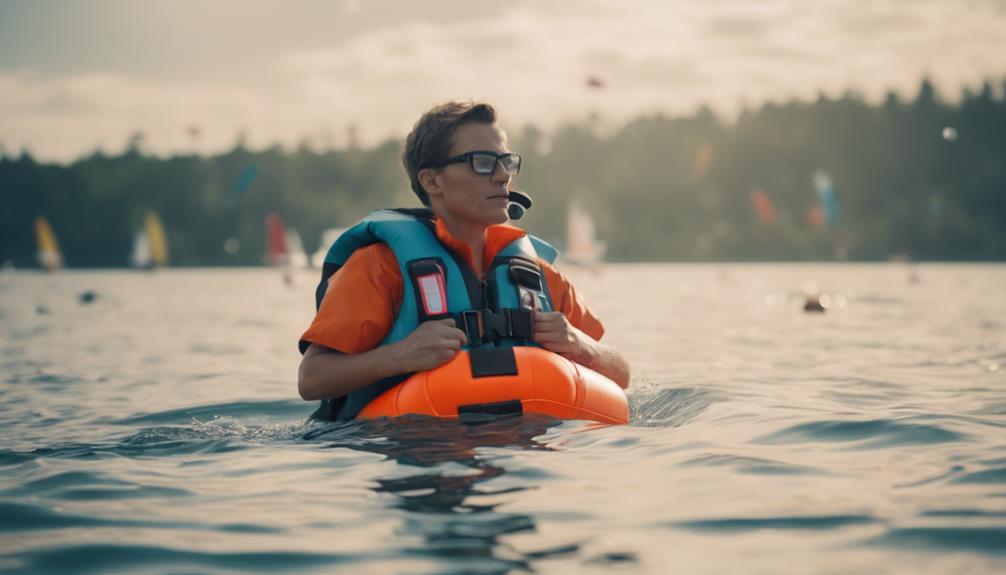
To enhance your safety during water sports activities, always remember to wear a Coast Guard-approved life jacket. The importance of wearing a life jacket can't be overstated, especially in unpredictable water conditions. No matter your skill level, a life jacket can be a lifesaver in emergencies.
Additionally, it's vital to establish clear communication practices while participating in water sports. Designate a spotter to relay hand signals to the driver for maximum safety. Learning basic hand signals such as thumbs up or down for speed adjustments, pat on the head for a return to the starting point, and hands overhead for signaling 'OK' are essential for effective communication on the water. These signals not only ensure a smooth experience but also contribute to overall safety.
Maximizing Fun and Safety

For an exhilarating and safe experience in water sports, focus on optimizing your gear and skills.
- Make sure to always wear a Coast Guard-approved life jacket to provide impact protection during water sports.
- Designate a spotter to effectively communicate needs to the driver, enhancing safety on the water.
- Learn and utilize basic watersports hand signals such as thumbs up or down for speed adjustments, a pat on the head to request a return, and hands overhead to signal you're okay.
- Boat drivers should maintain a safe distance from obstacles and remain focused on the water ahead to prevent accidents.
- Follow the manufacturer's recommendations for boat tubing and wakesurfing equipment to guarantee both safety and performance on the water.
Frequently Asked Questions
What Are the Tips for Water Safety?
For water safety, always wear a life jacket, stay informed of weather conditions, supervise children near water, learn CPR and water rescue skills, and know water conditions before activities. These essential tips guarantee a safe experience.
Are Water Sports Safe?
Water sports can be safe if you take precautions. Wear a life jacket, know your limits, and watch the weather. Stay hydrated, use the buddy system, and avoid alcohol. Learn water rescue skills and have a float plan.
How Do You Make Sure to Stay Safe While Playing Near Water?
When playing near water, always wear a Coast Guard-approved life jacket, designate a responsible spotter, and learn basic water sports hand signals. Use thumbs up or down for speed, hands overhead for 'OK,' and make sure proper equipment for a safe experience.
Why Is It Important to Be Safe in the Water?
Staying safe in the water is vital for your well-being. Following safety guidelines not only protects you from accidents but also guarantees a secure environment for all. Complying with regulations helps prevent injuries and promotes responsible water sports practices.
Conclusion
So, next time you hit the water for some adrenaline-pumping fun, keep these essential safety tips in mind to guarantee a smooth and enjoyable experience.
With proper precautions and awareness, you can conquer any water sport with confidence and ease.
Don't let the fear of danger hold you back – embrace the excitement of the waves and make unforgettable memories while staying safe and sound.
Stay vigilant, stay prepared, and most importantly, stay safe out there!

